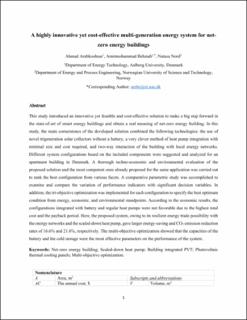| dc.contributor.author | Arabkoohsar, Ahmad | |
| dc.contributor.author | Behzadi, Amirmohammad | |
| dc.contributor.author | Nord, Natasa | |
| dc.date.accessioned | 2021-05-12T08:23:29Z | |
| dc.date.available | 2021-05-12T08:23:29Z | |
| dc.date.created | 2021-05-06T09:45:34Z | |
| dc.date.issued | 2021 | |
| dc.identifier.issn | 0196-8904 | |
| dc.identifier.uri | https://hdl.handle.net/11250/2755109 | |
| dc.description.abstract | This study introduced an innovative yet feasible and cost-effective solution to make a big step forward in the state-of-art of smart energy buildings and obtain a real meaning of net-zero energy building. In this study, the main cornerstones of the developed solution combined the following technologies: the use of novel trigeneration solar collectors without a battery, a very clever method of heat pump integration with minimal size and cost required, and two-way interaction of the building with local energy networks. Different system configurations based on the included components were suggested and analyzed for an apartment building in Denmark. A thorough techno-economic and environmental evaluation of the proposed solution and the most competent ones already proposed for the same application was carried out to rank the best configuration from various facets. A comparative parametric study was accomplished to examine and compare the variation of performance indicators with significant decision variables. In addition, the tri-objective optimization was implemented for each configuration to specify the best optimum condition from energy, economic, and environmental standpoints. According to the economic results, the configurations integrated with battery and regular heat pumps were not favorable due to the highest total cost and the payback period. Here, the proposed system, owing to its resilient energy trade possibility with the energy networks and the scaled-down heat pump, gave larger energy-saving and CO2 emission reduction rates of 16.6% and 21.6%, respectively. The multi-objective optimization showed that the capacities of the battery and the cold storage were the most effective parameters on the performance of the system. | en_US |
| dc.language.iso | eng | en_US |
| dc.publisher | Elsevier | en_US |
| dc.relation.uri | https://www.sciencedirect.com/science/article/pii/S019689042100296X?via%3Dihub | |
| dc.rights | Attribution-NonCommercial-NoDerivatives 4.0 Internasjonal | * |
| dc.rights.uri | http://creativecommons.org/licenses/by-nc-nd/4.0/deed.no | * |
| dc.title | A highly innovative yet cost-effective multi-generation energy system for net-zero energy buildings | en_US |
| dc.type | Peer reviewed | en_US |
| dc.type | Journal article | en_US |
| dc.description.version | acceptedVersion | en_US |
| dc.source.volume | 237 | en_US |
| dc.source.journal | Energy Conversion and Management | en_US |
| dc.identifier.doi | https://doi.org/10.1016/j.enconman.2021.114120 | |
| dc.identifier.cristin | 1908375 | |
| dc.relation.project | Norges forskningsråd: 262707 | en_US |
| dc.description.localcode | © 2021. This is the authors’ accepted and refereed manuscript to the article. Locked until 19/4-2023 due to copyright restrictions. This manuscript version is made available under the CC-BY-NC-ND 4.0 license http://creativecommons.org/licenses/by-nc-nd/4.0/ | en_US |
| cristin.ispublished | true | |
| cristin.fulltext | postprint | |
| cristin.qualitycode | 1 | |

